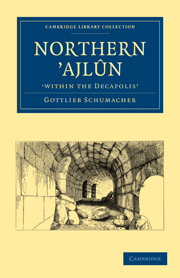Summary
OTHER PLACES IN THE DISTRICT OF ES-SIRU
ʾÂbis.—A small ruin on the shoulder above ʾAin es-Sahn, also called ʾAin et-Tâssi. The ruin is of little importance. The spring below is perennial, and rises in the small cave of a limestone rock in the Wâdy ʾAin es-Sahn, and flows westwards, watering a few tobacco and vegetable grounds; the water is clear as crystal and of good quality. The Wâdy has an abundant growth of Oleanders, Mallûl (Oak), Kharrub (Locust Tree), Butm (Terebinth), and ʾAbhar Oak. Two hundred yards to the south the perennial spring of ʾAin Kelâb wells out from beneath a rock ana joins the waters of the ʾAin es-Sahn, the two forming a charming brook, taking its course through an abundant growth of brushwood and shrubs.
ʾAin el-Kusab and ʾAin Ra'ân.—Two springs of moderate supply, flowing out on the northern slopes of Wâd el-Barûka, a gorge overgrown with cane jungle.
ʾAin Umm ej-Jrein.—A small perennial spring; above it, to the east, is the ʾAin Barûka of the same character.
ʾAin et-Turâb.—A spring at the head of Wâdy Samar; this gorge has as yet not been thoroughly explored. There are some ruins in the neighbourhood.
ʾAin es-Sukkar.—A fine spring near Malka, at the head of the Wâd el-Mallâki.
ʾAin ʾAtîyeh.—A small spring at the head of the Wâdy of the same name.
- Type
- Chapter
- Information
- Northern ’Ajlûn, 'within the Decapolis' , pp. 83 - 113Publisher: Cambridge University PressPrint publication year: 2010First published in: 1890

